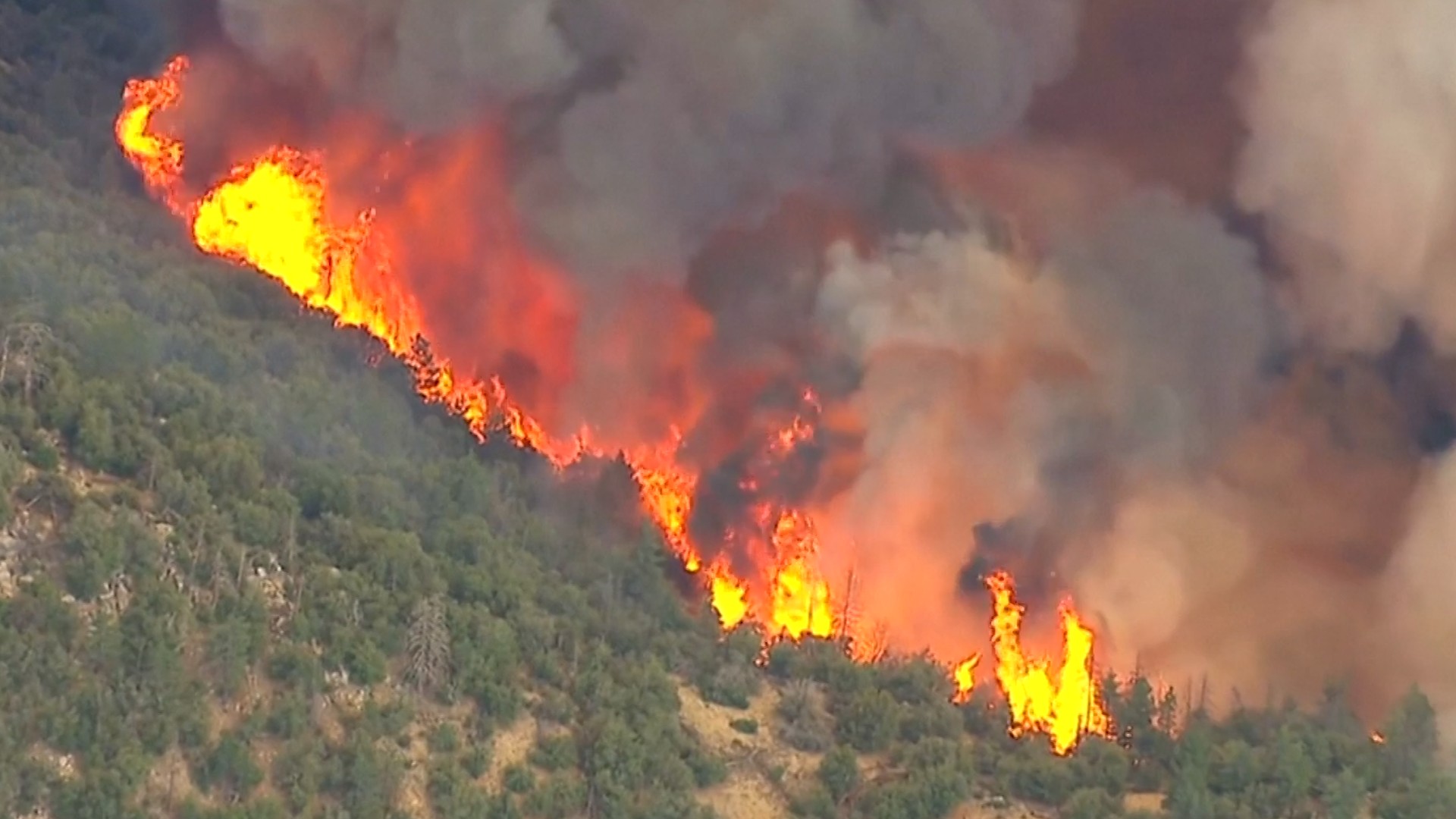People wearing air masks watch Donald Trump's motorcade as he drives to view damage from wildfires in Paradise, California, on Saturday. Photo by SAUL LOEB/AFP/Getty
The wildfires that have ravaged California over the past week were not only the deadliest in the state’s history, they’ve spewed so much smoke into the air that schools in Sacramento closed and the Oakland Raiders cancelled practice. A haze still hangs ominously over huge swathes of the state, from San Francisco to Los Angeles. Over the weekend, air quality in the Bay Area improved a bit, but is still at unhealthy levels. Monday morning, the region's Air Quality Index (AQI) number, a measure of how polluted the air is, was 171. That’s the same as notoriously smoggy Beijing, where it’s common to see citizens walking around everyday wearing air masks. The spate of air mask selfies from people in the Bay Area has been growing on Instagram.As the state grapples with the fires and their immediate aftermath, experts warn that the smoky air could have severe health consequences, and that people will have to learn to deal with atmosphere made smoggy by fires, because these blazes will be increasingly common thanks to climate change.“This should not be something we passively adapt to,” said Kari Nadeau, a physician and director of the Sean N. Parker Center for Allergy and Asthma Research at Stanford University. “This should be something we try to mitigate but unfortunately this has become the new norm.”As the Camp Fire in Northern California continues to burn, schools and universities in the Bay Area remain closed, and residents are being advised to avoid going outside at least until Tuesday, when rain is expected.In Southern California, where the Woolsey fire is 91 percent contained and evacuation orders are slowly lifting, residents are returning to their homes (if those homes are still there). The air quality in this part of the state, while not as severe as the Bay Area’s, still hovers in the range considered “unhealthy for sensitive groups,” like older adults and children, according to the AQI.Five days of exposure to high levels of air pollution is the equivalent of smoking one cigarette a day for an entire year, Nadeau said, and the adverse health effects can be immediate—coughing, dry or sore throat, watering eyes, headaches, and for some, asthma attacks. All are a result of the body trying to protect itself and expel these particles, creating more mucus. “These are small chemicals and they’re less than the size of 2.5 microns—like 1/30th of a little hair. So tiny,” she said. “You can’t taste them, you can’t smell them. It’s sight unseen.” It’s not so different from everyday pollution like emissions from cars and other particulate matter. “It’s the same,” said Nadeau. The difference is that these fires have caused much higher concentrations than normal.

The particles in the air here now are from everything that’s been burned: thousands of acres of trees, materials from houses, cars, paint thinner, plastics. “And the problem is, there’s no safe location that you can get away from this,” said Nadeau.“The only thing that gets the particles out of the sky is rain,” she continued. “But unfortunately, then all those particles get into the water supply. It’s not like they disappear. They’re molecules. So that’s the next thing you need to worry about, but let’s not go there.”For children, the health risks can be even more severe. Decades of research show a connection between heavy air pollution and asthma and deficient lung development in children. “We really need to watch now the babies that have been born during this particular time, (and) what happens to them in three years,” said Nadeau. “Will they have a higher rate of asthma? Will they have a higher rate of autoimmune disease? We don’t know. But that’s the type of study we need to do.”The growing number of wildfires across the world and their increasing intensity is driven by climate change, experts in the field agree (not, as President Donald Trump recently suggested, failure to rake leaves). The state is facing higher temperatures and drier conditions. The way to turn around what California Governor Jerry Brown recently called “the new abnormal” is to slow climate change down.“It’s always the same story: The way to control air pollution is not to emit it,” said
Anthony Wexler, director of the Air Quality Research Center at UC Davis. “Once it’s in the air, it’s there. And it will hang out without any way for us to control it. We need to do things to put a lid on this.”One way to mitigate harm from climate change is climate adaptation, finding creative ways to work within this new climate. “We can harvest all that woody material that’s accumulated in our forests and use it to make electricity,” suggested Wexler. The benefits would be two-fold, he said—thinning the forests, and creating renewable energy. “People have talked about doing this for decades and we don’t do it.”If nothing changes, there’s little debate it will only get worse: The state will see more frequent and bigger wildfires, and also dangerously unhealthy air as a result.For people currently in the Bay Area, staying indoors helps. Air purifiers do too, though they don’t eliminate the health risks entirely. “Masks can only help so much,” said Wexler, and they don’t offer protection if a person has facial hair. “If the mask is not sealing on your face, then the air’s going to go around it, and you’re not going to get any benefit.” Wearing a mask sealed on the face is uncomfortable, and only something you can do for a short time, he added.There are also risks associated with air masks, including increased heart rate and C02 build-up, which may outweigh the benefits. Sacramento County recently issued a warning for the N95 masks, saying that only people near a fire should use them and that they could be dangerous for those with heart and respiratory diseases.“I don’t like those solutions,” said Wexler, “because there are people who can’t afford (masks) or people who went to the hardware store too late, and why should they be suffering? We need to deal with the source.”All these are short-term fixes, and don’t get to the larger problem, Wexler emphasized.“It’s definitely getting worse every year,” he said. “It looks like we’re going to have these annual conflagrations, and not just our state—Washington, Oregon, Arizona—they’re all getting this stuff too. We’ll see more wildfires, we’ll see more houses lost, more people will die. There are certainly people dying from breathing this air pollution.”Sign up for our newsletter to get the best of VICE delivered to your inbox daily.
Advertisement
Advertisement

The particles in the air here now are from everything that’s been burned: thousands of acres of trees, materials from houses, cars, paint thinner, plastics. “And the problem is, there’s no safe location that you can get away from this,” said Nadeau.“The only thing that gets the particles out of the sky is rain,” she continued. “But unfortunately, then all those particles get into the water supply. It’s not like they disappear. They’re molecules. So that’s the next thing you need to worry about, but let’s not go there.”For children, the health risks can be even more severe. Decades of research show a connection between heavy air pollution and asthma and deficient lung development in children. “We really need to watch now the babies that have been born during this particular time, (and) what happens to them in three years,” said Nadeau. “Will they have a higher rate of asthma? Will they have a higher rate of autoimmune disease? We don’t know. But that’s the type of study we need to do.”The growing number of wildfires across the world and their increasing intensity is driven by climate change, experts in the field agree (not, as President Donald Trump recently suggested, failure to rake leaves). The state is facing higher temperatures and drier conditions. The way to turn around what California Governor Jerry Brown recently called “the new abnormal” is to slow climate change down.“It’s always the same story: The way to control air pollution is not to emit it,” said
Anthony Wexler, director of the Air Quality Research Center at UC Davis. “Once it’s in the air, it’s there. And it will hang out without any way for us to control it. We need to do things to put a lid on this.”
Advertisement
